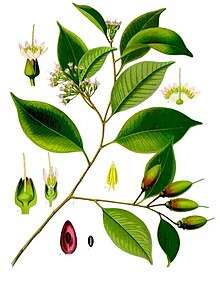| Payena | |
|---|---|
 | |
| Payena leerii [1] | |
| Scientific classification | |
| Kingdom: | Plantae |
| Clade: | Tracheophytes |
| Clade: | Angiosperms |
| Clade: | Eudicots |
| Clade: | Asterids |
| Order: | Ericales |
| Family: | Sapotaceae |
| Subfamily: | Sapotoideae |
| Genus: | Payena A.DC. [2] |
| Synonyms [2] | |
| |
Payena is a genus of plants in the family Sapotaceae, described as a genus in 1844. It is native to Southeast Asia. [2]
As of March 2024 [update] , Plants of the World Online recognised the following species: [2]
- Payena acuminata (Blume) Pierre – Thailand, Peninsular Malaysia, Borneo, Java, Sumatra
- Payena annamensis Lecomte – Vietnam
- Payena asiatica Chantar. – Thailand, Peninsular Malaysia, Sumatra
- Payena dantung H.J.Lam – Sumatra
- Payena dasyphylla (Miq.) Pierre – Sumatra, Peninsular Malaysia
- Payena endertii H.J.Lam – Sumatra
- Payena ferruginea J.T.Pereira – Borneo
- Payena gigas A.Bruggen – Borneo
- Payena grandistipula J.T.Pereira – Borneo
- Payena kapitensis J.T.Pereira – Borneo
- Payena khoonmengiana J.T.Pereira – Borneo
- Payena kinabaluensis J.T.Pereira – Borneo
- Payena lamii A.Bruggen – Borneo
- Payena leerii (Teijsm. & Binn.) Kurz. – Myanmar, Peninsular Malaysia, Borneo, Sumatra, Philippines
- Payena longipedicellata Brace ex King & Gamble – Peninsular Malaysia, Borneo
- Payena lucida A.DC. – Andaman Islands, Bangladesh, Myanmar, Thailand, Peninsular Malaysia, Borneo, Sumatra
- Payena maingayi C.B.Clarke – Thailand, Peninsular Malaysia
- Payena microphylla (de Vriese) Burck – Borneo
- Payena obscura Burck – Peninsular Malaysia, Borneo, Sumatra
- Payena pseudoterminalis H.J.Lam – Sumatra